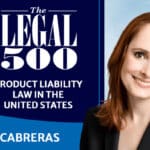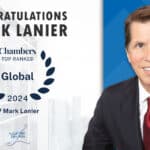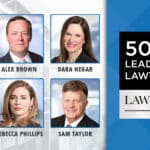Lawyers Switch Sides to Protect Settlements
By Susan Borreson
Texas Lawyer
Shepard Hoffman once donned a Darth Vader costume at one of the annual seminars he organizes for asbestos plaintiffs lawyers in a quirky demonstration of what he calls the evil ways of asbestos manufacturers.
So why did Hoffman and Houston plaintiffs lawyer W Mark Lanier, who in 1998 won what Lanier says is this country’s largest asbestos verdict $115.7 million defend a member of what Hoffman calls the “evil empire?”
Hoffman and Lanier say they had to help former asbestos manufacturing giant T&N Ltd. set aside a $1.6 billion default judgment won by Owens-Illinois Inc. to protect a huge source of settlements for victims.
Lanier and Hoffman say T&N will pay their expenses for their work on the default judgment, but they will be paid fees if they are retained for the rest of the litigation, which is likely.
But both lawyers say their involvement in the case isn’t about money – it’s about their clients. “If OI had been successful, OI would have walked away from asbestos litigation with out having paid one red dime or suffered one red cent of damages,” says Lanier, of Lanier, Parker & Sullivan who represents some 1 600 plaintiffs who have settled claims against T&N. “Meanwhile all of the victims out there in line to get T&N’s money would have been deprived.”
U.S. District Judge David Folsom of Texarkana on Feb. 28 vacated the judgment, which Lanier says is one of the largest default judgments ever entered in the United States. Folsom unsealed the order March 16.
Folsom ruled that although a legal assistant at T&N’s headquarters in Manchester, England, was served with the complaint, the company’s failure to answer the suit filed in June by Owens-Illinois was the result of an isolated human error.
T&N national trial counsel Paul Hanly says the company did not find out about the suit until Dec. 13, four months after the judgment had been entered and a week after Owens-Illinois obtained an ex parte order authorizing the company to collect.
The litigation between the two companies is being closely watched by the plaintiff’s bar, particularly in Texas, where lawyers say T&N, formerly known as Turner & Newall, is a major defendant.
Lawyers say the move by one major asbestos manufacturer against another is unprecedented in the annals of asbestos litigation, although defendant companies often bring in other companies as third-party defendants or fight with insurers.
Citing the Racketeer Influenced and Corrupt Organizations Act, Owens-Illinois alleges T&N conspired with Johns Manville Corp. and CAPE Asbestos, two other major asbestos manufacturers, from the 1920s through the 1960s to create a worldwide cartel for the sale of raw asbestos fibers.
T&N, which years ago got out of the asbestos business and is now an automotive parts company, allegedly sold the fiber to companies like Owens-Illinois, which used it in pipe insulation products.
Owens-Illinois, which sold asbestos-containing products from 1948 until 1958, alleges that T&N knew in the 1940s of the health risks that the fiber posed to end-users who handled asbestos insulation, but withheld that information from the British government, unions and customers.
Owens-Illinois alleges it never would have gotten into the asbestos business if it had known those risks, and did not discover the danger to end-users until 1964 or 1965, when an epidemiological study was published, says Richard Josephson, of Houston’s Baker Boils, who represents Owens-Illinois.
“Who would have bought raw asbestos from any of them if they knew that the people who were going to be exposed to that product would have been at risk of developing disease?” Josephson says.
Josephson says Owens-Illinois has filed a similar suit in Texarkana against CAPE Asbestos, now known as CAPE P.L.C. He says the British company’s policy is not to answer suits filed in the United States.
Josephson says Owens-Illinois did not discover the alleged conspiracy until 1998, after T&N was purchased by Federal-Mogul Corp., a Michigan automotive parts company. Owens-Illinois alleges that as part of a corporate restructuring, T&N was divesting itself of U.S. assets. Folsom rejected the argument and Hanly denies the allegation.
Josephson declines to elaborate because the entire case file except Folsom’s order vacating the default judgment is sealed. The case, originally filed in Marshall, has been transferred to U.S. District Judge T. John Ward.
Josephson maintains T&N owes Owens-Illinois more than $1 billion in damages for claims paid to asbestos victims and other losses the company suffered because of its involvement in the asbestos business.
But Lanier and Hoffman, who has won five punitive damage verdicts against Owens-Illinois, and other plaintiffs lawyers say the company’s claim of ignorance is absurd and has been disproved time and again in court.
“Both companies were well aware of the dangers back in the 30s and 40s, and for them to be suing each other is quite a remarkable abuse of the judicial system,” says Fred Baron, of Dallas’ Baron & Budd.
Indeed the knowledge of Lanier and Hoffman about what Owens Illinois knew and when it knew it is a key reason why T&N hired the pair, Hanly says. The company, facing a tight court schedule, had to find that expertise quickly and Hardy had just finished opposing Lanier in an asbestos injury case in Brazona County, he says
Hoffman has offices in Baltimore and Dallas, where he is of counsel with Stanley, Mandel & Iola. He serves as national trial counsel for asbestos plaintiffs firms across the country and is known for his annual seminar.
Lanier says the case also could signal a sea change in the historically united front that asbestos companies have presented in defense against claims. While T&N still faces years of asbestos claims, suits against Owens-Illinois are dwindling and should be finished in about eight years, Lanier says.
“I think we’re seeing an imploding of the asbestos defense conspiracy,” Lanier says. “I think asbestos companies conspired together to defend themselves, and have hidden documents, and distorted literature, and lied in discovery responses. I think through this case, we will probably see an implosion of that, and I think it’ll be to the benefit of the injured victims all over the country.”
Settlement in Danger?
More importantly for the plaintiffs bar, some fear that if Owens-Illinois prevails and wins big, T&N could go into bankruptcy, endangering a major settlement source for plaintiffs. T&N is one of the four most substantial contributors to the Center for Claims Resolution, a consortium of asbestos defendants and a major settling entity, Hoffman says. Owens-Illinois does not belong to the consortium.
Lanier and Hoffman acknowledge that their involvement in the case could raise some eyebrows. After all, the lawyers routinely accuse T&N of misconduct in ignoring the dangers of asbestos in personal-injury litigation, and T&N routinely denies it. And the plaintiffs bar discovered much of the documentation used to back that claim in court.
But Lanier and Hoffman say they are making no excuses for T&N’s alleged conduct, and did not defend it at the hearing to set aside the default judgment – just the opposite. Hoffman says he argued at the hearing that the judge should assume T&N “did everything it’s accused of doing.”
They insist that their defense of T&N does not conflict with or compromise their clients’ interests, even if they stay on the case and are paid for their work.
“I think we both are beyond comfortable with what we’ve done,” Hoffman says. T&N waived any claim for conflict of interest in the lawyers’ personal-injury litigation, Hanly says.
“In my view, they are free to assert that – if they think it’s appropriate – that T&N’s conduct was improper,” says Hanly, a partner in New York’s Coblence & Warner. “I don’t necessarily agree with that, but they’re free to do that, and they didn’t take any position in this litigation that’s inconsistent with that.”
Lanier and Hoffman advised their asbestos clients about their involvement in the case, and Lanier also consulted with University of Texas School of Law professors Charles Silver and Lynn A. Baker, experts in lawyer ethics.
Silver says there is no ethical conflict because the lawyers disclosed their work and any payment to their clients and obtained a waiver of conflict from T&N.
“In Texas, there’s no prohibition on representing a client and being adverse to the client at the same time, as long as the matters are either unrelated or with the clients’ consent,” Silver says.
“I’ll never stand up and say, “Turner & Newall did nothing bad,” Hoffman says. “The contrary is true. Not only do I know the contrary is true, I helped prove that. This has nothing to do with exonerating Turner & Newall – quite the contrary.”
Both lawyers say they also sent out more than two dozen letters to asbestos plaintiffs firms around the country asking for their support in setting aside the judgment. Lanier says they received some 25 letters of support from lawyers representing 200,000 claimants.
“Only one person objected, and he changed his mind over the phone,” Lanier says.
Indeed, Lanier says Owens-Illinois approached him about helping the company in the case, and asked him to turn over his T&N file, but he refused. Josephson says while he did not talk to Lanier about it, he does not know whether anyone else at the company did. The general counsel of Owens-Illinois, Phil McWeeny, did not return two phone calls seeking comment.
“I have been approached by two other asbestos companies and asked to sue Turner & Newall under the same idea. And I’ve told both of them no,” Lanier says. “I couldn’t do it ethically, and I think it’s a loser case. These facts have been out there for 10 years.”
This article is reprinted with permission from the April 3, 2000 issue of Texas Lawyer. © Texas Lawyer.








